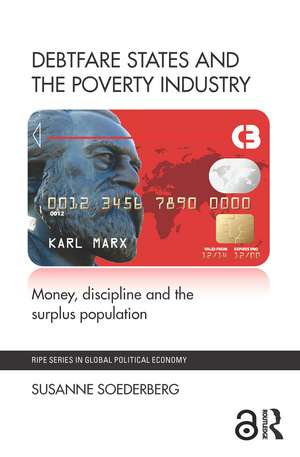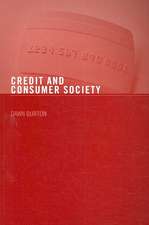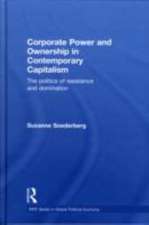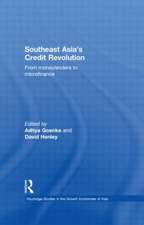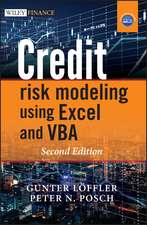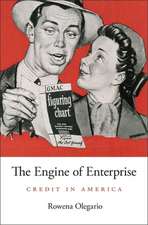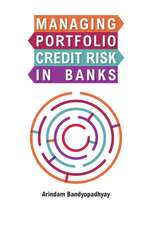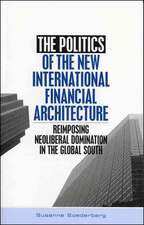Debtfare States and the Poverty Industry: Money, Discipline and the Surplus Population
Autor Susanne Soederbergen Limba Engleză Paperback – 11 sep 2014
http://www.bisa-ipeg.org/ipeg-book-prize-2015-winner-announced/
Under the rubric of ‘financial inclusion’, lending to the poor –in both the global North and global South –has become a highly lucrative and rapidly expanding industry since the 1990s. A key inquiry of this book is what is ‘the financial’ in which the poor are asked to join. Instead of embracing the mainstream position that financial inclusion is a natural, inevitable and mutually beneficial arrangement, Debtfare States and the Poverty Industry suggests that the structural violence inherent to neoliberalism and credit-led accumulation have created and normalized a reality in which the working poor can no longer afford to live without expensive credit.
The book further transcends economic treatments of credit and debt by revealing how the poverty industry is extricably linked to the social power of money, the paradoxes in credit-led accumulation, and ‘debtfarism’. The latter refers to rhetorical and regulatory forms of governance that mediate and facilitate the expansion of the poverty industry and the reliance of the poor on credit to augment/replace their wages. Through a historically grounded analysis, the author examines various dimensions of the poverty industry ranging from the credit card, payday loan, and student loan industries in the United States to micro-lending and low-income housing finance industries in Mexico.
Providing a much-needed theorization of the politics of debt, Debtfare States and the Poverty Industry has wider implications of the increasing dependence of the poor on consumer credit across the globe, this book will be of very strong interest to students and scholars of Global Political Economy, Finance, Development Studies, Geography, Law, History, and Sociology.
The Open Access version of this book, available at http://www.taylorfrancis.com/books/e/9781315761954, has been made available under a Creative Commons Attribution-Non Commercial-No Derivatives 4.0 license.
https://www.youtube.com/watch?v=2lU6PHjyOzU
| Toate formatele și edițiile | Preț | Express |
|---|---|---|
| Paperback (1) | 389.27 lei 6-8 săpt. | |
| Taylor & Francis – 11 sep 2014 | 389.27 lei 6-8 săpt. | |
| Hardback (1) | 1003.43 lei 6-8 săpt. | |
| Taylor & Francis – 15 sep 2014 | 1003.43 lei 6-8 săpt. |
Preț: 389.27 lei
Nou
Puncte Express: 584
Preț estimativ în valută:
74.50€ • 77.49$ • 61.50£
74.50€ • 77.49$ • 61.50£
Carte tipărită la comandă
Livrare economică 14-28 aprilie
Preluare comenzi: 021 569.72.76
Specificații
ISBN-13: 9780415822671
ISBN-10: 041582267X
Pagini: 302
Ilustrații: 1 black & white illustrations, 1 black & white line drawings
Dimensiuni: 156 x 234 x 20 mm
Greutate: 0.45 kg
Ediția:New.
Editura: Taylor & Francis
Colecția Routledge
Locul publicării:Oxford, United Kingdom
ISBN-10: 041582267X
Pagini: 302
Ilustrații: 1 black & white illustrations, 1 black & white line drawings
Dimensiuni: 156 x 234 x 20 mm
Greutate: 0.45 kg
Ediția:New.
Editura: Taylor & Francis
Colecția Routledge
Locul publicării:Oxford, United Kingdom
Public țintă
Postgraduate and UndergraduateCuprins
Introduction. Part I: Theorizing Money, Credit and Debtfare States Chapter 1: Demystifying Money, Chapter 2: The Power and Paradoxes of Credit, Chapter 3: Debtfare States, Part II: Debtfarism and the Poverty Industry in the United States, Preface to Part II: Debtfarism and the Making of the Poverty Industry, Chapter 4: Debtfarism and Credit Card Industry, Chapter 5: Debtfarism and Student Loan Industry, Chapter 6: Debtfarism and Payday Loan Industry, Part III: Debtfarism and the Poverty Industry in Mexico, Preface to Part III: Debtfarism, Development, and Dispossession, Chapter 7: Global Debtfarism and Universalization of Financial Inclusion, Chapter 8: Debtfarism and the Microfinance Industry, Chapter 9: Debtfarism and the Housing Industry, Conclusion.
Recenzii
This penetrating and original book introduces a new concept to the late-neoliberal lexicon, debtfare, as credit contracts displace social contracts, entrenching a parasitic "poverty industry." A compelling and significant contribution. Jamie Peck, Canada Research Chair in Urban & Regional Political Economy, University of British Columbia, Canada.
In the grand tradition of Marx, Simmel, Mauss and Harvey, Soederberg reveals the powers and paradoxes of credit as an instrument of capital accumulation, class regulation, and symbolic subjugation. A timely and stimulative contribution to the scientific and civic reevaluation of the role of finance in the workings of neoliberalism as a distinctive form of rule. Loïc Wacquant, University of California, Berkeley, author of Urban Outcasts and Punishing the Poor: The Neoliberal Government of Social Insecurity.
Debtfare is a necessary term and book to grasp the present moment. A political economy of the baleful poverty industry it provides a conceptual antidote to coercive financial inclusion by enlisting the force of Marx, Money and the State. Randy Martin, Faculty Director of Art and Public Policy, New York University, USA.
Here is a radical inquiry that does not fall into the easy language of "more"—more debt, more poverty, and on. Rather than documenting the sufferings of the poor, it examines the machinery that combines states and the poverty sector – a kind of new state-industrial complex. This unflinching examination is a major contribution to our understanding of poverty, business, and the state. Saskia Sassen, Robert S. Lynd Professor of Sociology, Columbia University, author of Expulsions.
Susanne Soederberg’s Debtfare States and the Poverty Industry (here forward Debtfare States) is perhaps the most rigorous historical materialist analysis of the state’s role in transforming the "surplus population" into a platform for credit-led accumulation.
Debtfare States should be required reading for radical financial geographers interested in role of the state in finance-led accumulation.
Mark Kear, University of Arizona
In the grand tradition of Marx, Simmel, Mauss and Harvey, Soederberg reveals the powers and paradoxes of credit as an instrument of capital accumulation, class regulation, and symbolic subjugation. A timely and stimulative contribution to the scientific and civic reevaluation of the role of finance in the workings of neoliberalism as a distinctive form of rule. Loïc Wacquant, University of California, Berkeley, author of Urban Outcasts and Punishing the Poor: The Neoliberal Government of Social Insecurity.
Debtfare is a necessary term and book to grasp the present moment. A political economy of the baleful poverty industry it provides a conceptual antidote to coercive financial inclusion by enlisting the force of Marx, Money and the State. Randy Martin, Faculty Director of Art and Public Policy, New York University, USA.
Here is a radical inquiry that does not fall into the easy language of "more"—more debt, more poverty, and on. Rather than documenting the sufferings of the poor, it examines the machinery that combines states and the poverty sector – a kind of new state-industrial complex. This unflinching examination is a major contribution to our understanding of poverty, business, and the state. Saskia Sassen, Robert S. Lynd Professor of Sociology, Columbia University, author of Expulsions.
Susanne Soederberg’s Debtfare States and the Poverty Industry (here forward Debtfare States) is perhaps the most rigorous historical materialist analysis of the state’s role in transforming the "surplus population" into a platform for credit-led accumulation.
Debtfare States should be required reading for radical financial geographers interested in role of the state in finance-led accumulation.
Mark Kear, University of Arizona
Descriere
This book theorizes the politics of debt and credit that underpins the expansion of consumer credit to the poor and addresses the role of states in facilitating consumer credit, in the developed and developing world. It features a range of case studies on pension securitization, credit cards, payday and student loans in the United States, and micro-lending and housing finance in Mexico.
https://www.youtube.com/watch?v=2lU6PHjyOzU
https://www.youtube.com/watch?v=2lU6PHjyOzU
